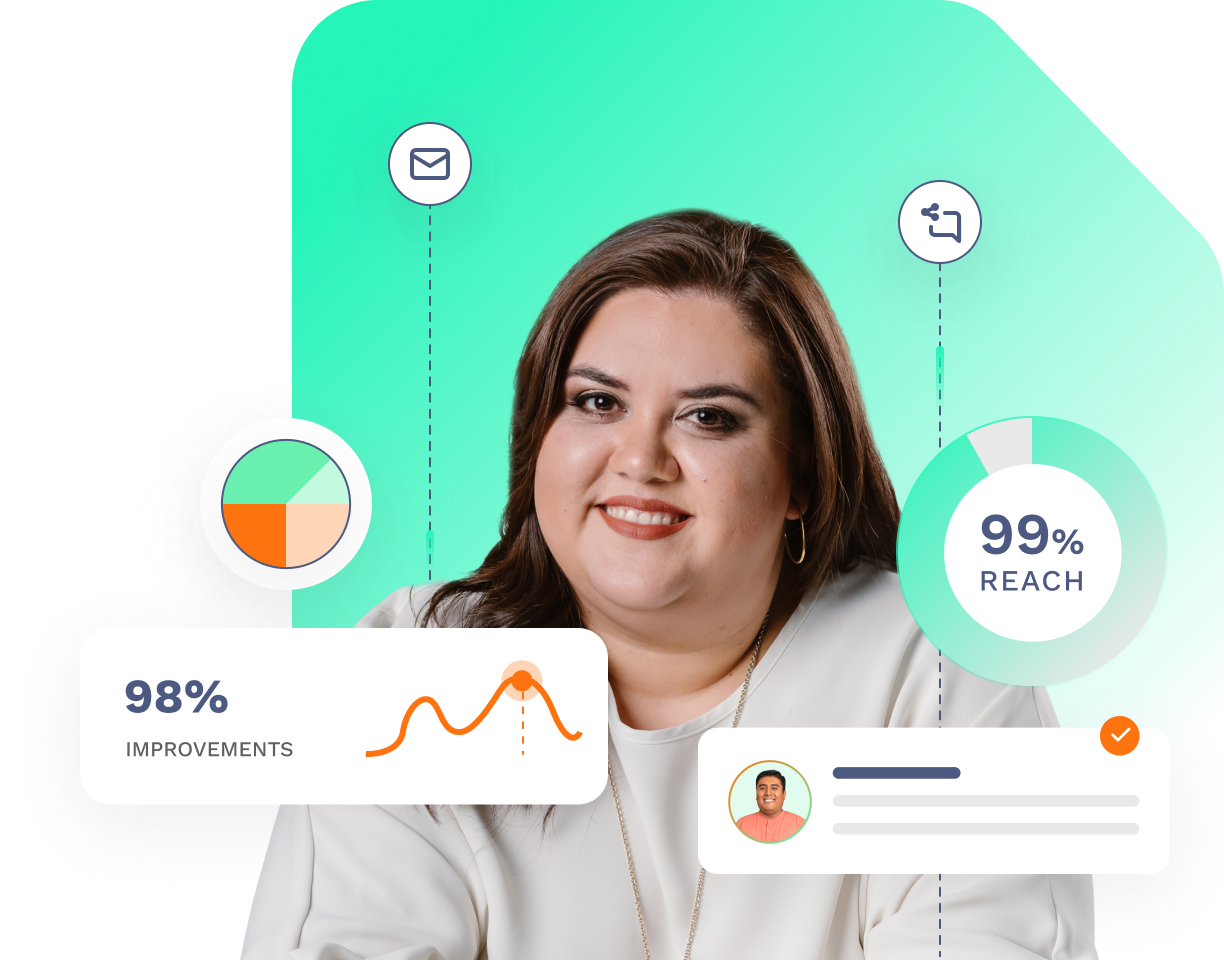Website Development
5 Signs Your Website Needs a Good UX Design Overhaul

Lourdes Calderón
Lourdes Calderón | Oct 21, 2024 | 7 MIN READ
Oct 21, 2024 7 MIN READ

Your website is often the first impression you make on potential customers. A well-designed website with a smooth user experience (UX) can turn visitors into loyal fans, but a poorly designed one can leave them frustrated and clicking away. Good UX design isn't just about aesthetics; it's about creating a user-friendly experience that guides visitors towards your goals, whether it's making a purchase, subscribing to a newsletter, or simply learning more about your brand. A website riddled with UX issues can have serious consequences. Confusing navigation, slow loading times, and unclear calls to action can all lead to high bounce rates, lost conversions, and ultimately, lost revenue. But how do you know if your website is suffering from a bad case of UX neglect? Don't worry, we've got you covered.
Sign #1: High Bounce Rate and Low Engagement
A high bounce rate is a strong indicator that users are encountering a frustrating maze-like experience on your website. But what does a high bounce rate actually mean? In website analytics, bounce rate refers to the percentage of visitors who leave your website after viewing only one page. This essentially means they entered the maze, took one look around, and decided to find another exit. While a low bounce rate is natural, a consistently high rate (generally considered above 60%) suggests a significant problem. It indicates that users are failing to find what they're looking for or encountering roadblocks that prevent them from engaging further.

Here's where good UX design comes in. If your website has confusing navigation, visitors might bounce because they can't find the information they need. Similarly, slow loading times can lead to frustration and prompt users to quit before they even get started. These are just a couple of examples of how poor UX design can contribute to a high bounce rate and low engagement.
Sign #2: Difficulty Completing Desired Actions
CTAs are clear instructions that tell users what you want them to do next. Good UX design ensures these CTAs are prominent, easy to understand, and encourage users to take action, whether it's "Buy Now," "Subscribe," or "Download Our Guide." They are crucial for driving conversions, which could be anything from a sale to a lead capture.
In the following example, NordVPN highlights the "Get the Deal" button and incorporates a countdown timer to instill a sense of urgency, thereby motivating users to take action before the limited-time offer concludes.
However, a poorly designed website can throw up roadblocks that make it difficult for users to find or complete these desired actions. This can happen in a few ways:
Unclear CTAs: Imagine CTAs that blend into the background or use generic language like "Click Here." These don't tell users what they'll gain by taking action, leading to confusion and hesitation.
Hidden CTAs: CTAs strategically placed above the fold (the part of the website visible without scrolling) are more likely to be seen. But if your CTAs are buried deep within lengthy content or hidden behind confusing menus, users might miss them altogether.
Problematic Forms: Long, overly complex forms with unclear instructions can discourage users from completing them. Additionally, technical issues like broken buttons or error messages during checkout can completely derail the conversion process.
These are just a few examples of how UX issues can make it difficult for users to complete desired actions on your website. By focusing on clear CTAs, user-friendly forms, and a smooth conversion funnel, you can ensure a seamless experience that encourages users to take the next step.
Sign #3: Negative User Feedback and Reviews
Good UX design minimizes negative user feedback and reviews by focusing on user-friendly features and a frustration-free experience. User feedback can be a goldmine for understanding how people perceive your website. While positive reviews are always welcome, negative feedback can be an invaluable tool for identifying UX problems.

Frustrated users often take to social media or contact forms to vent their complaints. By paying close attention to these comments and reviews, you can gain valuable insights into the specific pain points users are experiencing on your website. Here are some examples of negative user feedback that can point towards UX issues:
- Navigation Complaints: Comments like "I couldn't find what I was looking for" or "The navigation is way too confusing" highlight potential problems with website structure and labeling. Functionality Issues: Feedback mentioning difficulties with forms, broken links, or slow loading times indicate problems that hinder user interaction.
- Layout Dissatisfaction: Complaints about cluttered interfaces, overwhelming visuals, or mobile-unfriendliness suggest the website design needs to be streamlined and optimized. It's important to remember that not all feedback is created equal. While some users might offer specific suggestions for improvement, others might simply express frustration.
However, by analyzing the common themes and frustrations expressed in user feedback, you can start to identify recurring UX issues that need to be addressed. By prioritizing good UX design, you can proactively address these issues and create a website that users find enjoyable and easy to use.
Sign #4: Inconsistent Branding and Visual Design
Good UX design emphasizes consistent branding and visual design to create a cohesive user experience. When your website's visual design – fonts, colors, logos, imagery – clashes with your established brand identity, it creates confusion for users. They might wonder if they've stumbled onto the right website or if the information they're seeing is legitimate, which undermines good UX design principles. This inconsistency can lead to a negative first impression and ultimately, lost trust in your brand.

Outdated or irrelevant visuals can make your website appear unprofessional and unappealing. Think blurry stock photos, fonts that are difficult to read, or color schemes that clash. Not exactly the kind of visual experience you want to offer potential customers. A visually appealing and consistent website is essential for standing out from the crowd. By ensuring your website aligns seamlessly with your overall brand identity, you create a cohesive and trustworthy experience for your users.
Sign #5: Lack of Mobile Responsiveness
Good UX Design ensures websites are mobile-responsive, providing an optimal experience for users on any device. If your website doesn't adapt to different screen sizes, mobile users will be greeted with a distorted mess. Text might be too small to read, buttons might be impossible to click, and menus might be hidden or unusable.
This frustrating experience can quickly alienate mobile users, which goes against core principles of good UX design, causing them to abandon your website and head straight to your competitor who offers a seamless mobile experience.

Here are some of the potential drawbacks of a non-responsive website:
- Slow Loading Times: Websites crammed with desktop-optimized content can take an eternity to load on mobile devices, leading to impatient users bouncing off before they even see your content.
- Distorted Content: Images and text that aren't adjusted for smaller screens will appear pixelated or squished together, making it difficult for users to navigate and understand your message.
- Difficulty Using Features: Features designed for a desktop environment, like complex forms or drop-down menus, can become unusable on a touch screen, further hindering user interaction.
By prioritizing mobile responsiveness, you ensure your website delivers a smooth and user-friendly experience for everyone, regardless of the device they're using. This not only improves user satisfaction but can also lead to increased engagement and conversions.
Ready to transform your website from frustrating maze to user-friendly haven?
At The Orange Box, our team of UX design experts specializes in crafting websites that are not only visually appealing but also intuitive and achieve your business objectives. Our website strategy and development services take a holistic approach, focusing on user experience, clean design, and conversion optimization. We'll work closely with you to understand your target audience, goals, and brand identity to create a website that drives results.
TABLE OF CONTENTS
Stay Updated with Our
Latest Posts
Subscribe now to receive the freshest content, insights, and updates directly in your inbox.



2024 © The Orange Box Agency – All rights reserved





.png?width=90&height=90&name=facebook%20(1).png)
.png?width=94&height=96&name=Vector%20(1).png)